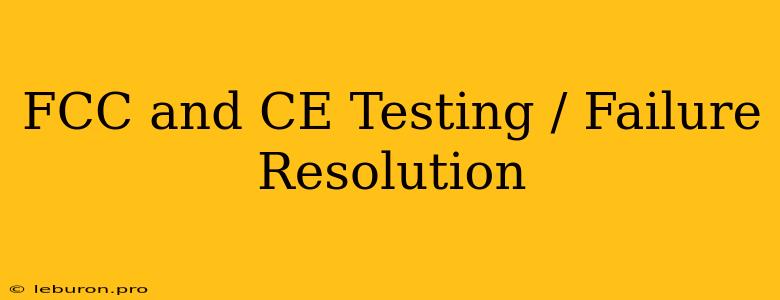Navigating the Labyrinth: Understanding FCC and CE Testing and Resolving Failures
Successfully bringing a product to market requires meticulous attention to detail, particularly when it comes to regulatory compliance. In the global landscape, two of the most prominent certifications, the FCC (Federal Communications Commission) in the United States and the CE (Conformité Européenne) in Europe, play a crucial role in ensuring products meet safety and electromagnetic compatibility (EMC) standards. While navigating the intricacies of FCC and CE testing can be daunting, understanding the process and potential pitfalls is essential for a smooth launch. This article delves into the significance of these certifications, outlines common failure points, and provides actionable strategies for resolving them.
The Crucial Role of FCC and CE Testing
FCC: Ensuring Safety and Interference Prevention in the US
The FCC is responsible for regulating radio frequencies and ensuring electronic devices do not interfere with other wireless communications. FCC testing encompasses a comprehensive range of evaluations, including:
- Radio Frequency (RF) Emissions: This evaluates the amount of electromagnetic radiation emitted by a device to ensure it stays within permissible limits.
- Spurious Emissions: This assesses the presence of unintended radio frequencies that could interfere with other devices.
- Conducted Emissions: This measures the electromagnetic interference conducted through power lines or other cables.
- Radiated Emissions: This measures the electromagnetic interference emitted into the surrounding environment.
CE: Harmonizing Standards across Europe
The CE marking, a symbol of conformity, indicates a product meets European Union (EU) safety, health, and environmental requirements. CE testing involves demonstrating compliance with specific harmonized standards related to product categories. Common aspects of CE testing include:
- Safety Requirements: Ensuring products meet safety standards, including electrical safety, mechanical safety, and fire safety.
- Electromagnetic Compatibility (EMC): Confirming that the product does not emit or is not susceptible to electromagnetic interference.
- Low Voltage Directive (LVD): Applicable to electrical equipment operating at voltages between 50 and 1000 volts, ensuring electrical safety.
Common Failure Points and Resolution Strategies
While both FCC and CE testing aim to ensure product safety and compatibility, certain factors can lead to failures. Understanding these common pitfalls and their solutions is vital for a successful certification process.
1. Insufficient Documentation:
Failure: Incomplete or poorly organized technical documentation, including user manuals, schematics, and test reports, can lead to rejection.
Resolution:
- Thorough Documentation: Maintain detailed and organized technical documentation that clearly outlines the product's design, functionality, and safety features.
- Compliance Standards: Ensure all documentation explicitly states the product's compliance with the relevant FCC and CE standards.
- Clear Test Reports: Submit comprehensive test reports that clearly present the test results and methodologies used.
2. Inadequate Product Design:
Failure: Poorly designed components, inadequate shielding, or lack of proper grounding can result in excessive emissions or susceptibility to interference, leading to test failures.
Resolution:
- Design Review: Conduct thorough design reviews to identify potential issues related to EMI/RFI (electromagnetic interference/radio frequency interference) and safety hazards.
- Shielding and Grounding: Implement effective shielding techniques and proper grounding practices to minimize electromagnetic interference.
- Component Selection: Choose components with low EMI characteristics and ensure they meet relevant safety requirements.
3. Improper Testing Procedures:
Failure: Inaccurate test setups, inadequate test equipment, or failure to follow standardized testing procedures can result in inaccurate measurements and failed tests.
Resolution:
- Accredited Labs: Partner with accredited and experienced testing laboratories that have expertise in FCC and CE testing.
- Test Equipment Calibration: Ensure all test equipment is properly calibrated and maintained according to regulatory requirements.
- Strict Adherence to Standards: Follow all prescribed test procedures and standards diligently, ensuring accurate measurements and results.
4. Insufficient Pre-Testing:
Failure: Skipping thorough pre-testing before submitting products for official certification can lead to unexpected failures and delays.
Resolution:
- Internal Pre-testing: Conduct thorough internal pre-testing using similar test equipment and procedures as official certification labs.
- Early Identification: Identify and address potential issues during pre-testing to avoid delays and costly re-tests.
- Simulation and Modeling: Utilize electromagnetic simulation software to predict potential problems and optimize product design for successful certification.
5. Lack of Communication and Collaboration:
Failure: Insufficient communication between the manufacturer, testing lab, and certification body can lead to misunderstandings, delays, and potential test failures.
Resolution:
- Open Communication: Maintain open and clear communication channels between all stakeholders involved in the certification process.
- Regular Updates: Provide regular updates on the product's development, testing progress, and any issues encountered.
- Clear Expectations: Clearly communicate expectations and timelines to ensure all parties are aligned on the certification process.
Overcoming Challenges and Achieving Success
Navigating FCC and CE testing can be challenging, but understanding the potential hurdles and implementing proactive strategies can greatly improve the chances of success. The journey may involve several rounds of testing, revisions, and documentation updates. By addressing issues early on, collaborating with experts, and ensuring comprehensive testing, manufacturers can achieve seamless certification and bring their products to market with confidence. Ultimately, a successful certification process not only validates product safety and compatibility but also builds trust with consumers, contributing to a positive brand reputation and long-term market success.
